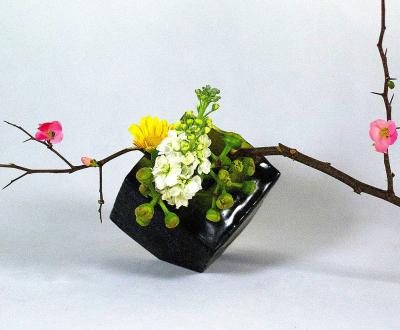Ikebana
The Japanese Art of Flower Arrangement
Ikebana is a Japanese traditional art consisting in the arrangement of cut flowers and plants in a pot or a vase in various colors, sizes and directions while creating a harmonious visual unity. This ephemeral artwork represents a scenery or the artist’s feelings, a message to convey or a memory.
It is said that ikebana originated from Choho-ji temple (Rokkaku-do) in Kyoto.
The Japanese-style flower arrangement requires the use of seasonal flowers. In the same way as haiku (a style of Japanese poetry) composition, the bouquet is an association of nature to the artist’s emotions. Ikebana flower arrangement is based on three main traditional rules (asymmetry, void and depth) but it adapted successfully to modern shapes, notably through the choice of a container that will highlight the flowers.
To practice ikebana flower design, one needs cut flowers or plant materials, a container, a kenzan flower frog, a pruning shears and water.
Ikebana from traditional to contemporary styles
Three styles of flower arranging embody the expression of the societies from which they originate, as much as the will of the flower designer:
- Rikka (立花) is characterized by vertical flowers,
- Shoka (生花) structures the composition into 3 lines and therefore 3 types of plants. It is a simplified version of rikka.
- Jiyuka (自由花), is the free style, more recent. It must also represent a season.
Several types of vases can be used to bring out the creations. Rikka style uses tall and narrow vases. The vases of monbana type are wide and shallow and can be used in the two other styles to create a multidirectional flower arrangement, by using for example, crooked branches of willow. Lastly, yubana is a modern vase that can be created from any container that was not initially designed to hold flowers. It can range from a lacquered bento 🍱 box to a broken vase.
The refinement of floral composition
The arrangement of flowers is made following a very specific order. First, the main flower or plant, called shu (主), is placed. To ensure harmony with the vase, it must be twice or thrice its size. If the stem is too thick to be maintained by the flower frog, it must be cut at the base. Then the smaller plants, called kyaku (客), are added, and they must be at least the same size as the vase. In a floral composition, the balance between the highest flower and the others is very important, as well as the arrangement and the literal highlight of the plants: ikebana initially started as an offering to Buddha, the elevation of the composition served to showcase one’s devotion and to pay tribute to the deity through the beauty of the bouquet.
Nowadays, the religious aspect still exists, but the focus is also (mainly) put on Zen: ikebana is an art to soothe the spirit and the design must reflect its creator’s state of mind. The practice and the time required for creation put the flower artist in a contemplation state where all that matters is the completion of a perfect artwork true to their aesthetics. The bouquet might not suit everyone, but the spectator must nonetheless sense the underlying harmony. A complete involvement of the creator is thus necessary to compose the arrangement. An ikebana bouquet is to be admired from the bottom to the top, following the lines and the elevation of the flowers towards the sky.
The final arrangement is often displayed along with a drawing or a painting of a natural scenery. It allows to keep a connection between nature and its representation that is the bouquet, which also is a human creation. Flowers and plants can be used for their aesthetic aspects, but for the Japanese, they are also embedded with symbolic values playing an important role in the composition.
The hanakotoba (花言葉, literally "flowers language") helps create bouquets that are as beautiful as significant. In the Japanese flowers’ symbolic, yellow camellias evoke nostalgia, narcissus show respect, and peonies show courage.


